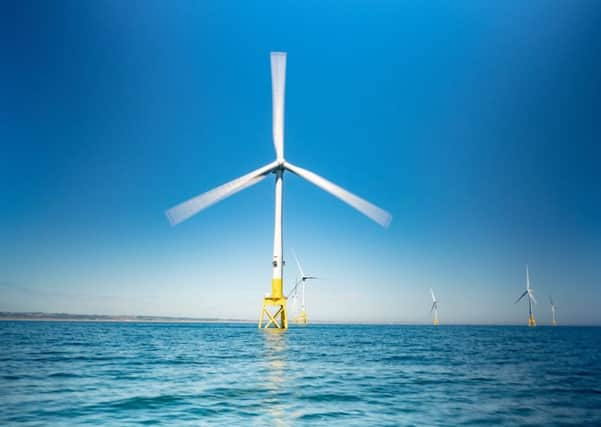Insight: How green is the next frontier of wind power in Scotland?


It’s impossible not to feel a sense of awe when you get up close to an offshore wind farm. Only then can you appreciate the true scale of the towering structures – in this case as tall as London’s BT Tower or three Scott Monuments stacked on top of each other.
But what was probably most surprising for me on my visit to Aberdeen Bay was the relative lack of noise. I had expected to hear a giant, rhythmic whomping sound and feel the turbulence as the rotors with a diameter of 164 metres chewed the air. It was all remarkably silent, save for the sea breeze, and strangely peaceful, hypnotic even.
Advertisement
Hide AdAdvertisement
Hide AdThe way things are moving such developments could soon become almost as familiar a sight as their land-based counterparts. Offshore wind is the next big thing for the UK, particularly Scotland. Not only does it produce renewable electricity, helping the country achieve its climate targets, it is opening up a whole new industry – and perhaps offering a kiss of life to one that has been anticipating the last rites.
With more than 6,000 miles of mainland coastline, Scotland has a lot of sea. And our much-cursed climate means we’ve also got plenty of wind. Globally the North Sea is considered one of the best places to build offshore wind farms because of its relatively shallow water and high wind speeds.
Scotland also has something else that gives us an advantage in the bid to build a thriving offshore wind sector – 50 years of expertise in undersea engineering, thanks to our oil and gas heritage. Add to that the country’s experience in onshore wind, which has been growing steadily and has matured over the past couple of decades.
All this together means Scotland can move swiftly to take advantage of its offshore potential.
What’s so good about offshore wind?
Offshore wind farms have the same green credentials as land-based turbines – they create renewable energy, do not consume water, do not emit environmental pollutants or greenhouse gases, while also providing a domestic energy source and creating jobs. Key advantages lie in the fact that offshore wind speeds tend to be faster and more consistent than on land, reducing energy intermittency associated with onshore turbines. Also being further away from human habitation means reduced visual impact and disturbance to local residents.
So where are we at?
Scotland currently has five operational offshore wind farms, mainly pilot schemes – including the world’s first floating offshore site – together amounting to more than 900 megawatts of installed capacity.
Scotland’s largest site, the Beatrice scheme, located off the Caithness coast, became fully operational this summer. With 84 turbines, it can generate a massive 588 megawatts of electricity – enough for 450,000 homes – and provides more than half of all the offshore wind generated in the UK.
There are a number of others in development, including four giant commercial projects in the Forth and Tay – 450MW Neart na Gaoithe, 784MW Inch Cape and 1,050MW Seagreen Alpha and Bravo, with up to 335 turbines between them.
Advertisement
Hide AdAdvertisement
Hide AdThe offshore wind sector is considered a UK success story, with the largest installed capacity in the world to date. Its contribution to annual generation increased from 0.8 per cent in 2010 to 6.2 per cent in 2017, and is expected to reach around 10 per cent by 2020. More than 7,000 people are already directly employed in the sector nationwide, and this is likely to increase.
So strong is the confidence in offshore wind, which has seen costs fall faster than anyone could have foreseen a decade ago, that Westminster has agreed a sector deal as part of the UK’s Industrial Strategy. This commitment aims to see offshore wind contributing up to 30 gigawatts of generating capacity by 2030.
Eight UK “clusters” have been formed under the sector deal, with two in Scotland – DeepWind, which covers northern and western Scotland, and Forth & Tay Offshore. The clusters are partnerships of industry, academia and the public sector, with the aim of developing a new offshore wind supply chain.
The Offshore Renewable Energy (ORE) Catapult, a technology innovation and research centre for offshore wind, wave and tidal energy, has been set up to support the emerging sector.
ORE Catapult’s Andrew Macdonald said: “Offshore wind is absolutely key to the future low-carbon economy. It’s a big opportunity for the North Sea and our job is to identify the challenges and help innovators through to market.”
What’s coming next?
Crown Estate Scotland, which manages leasing of the seabed out to 12 nautical miles and holds the rights to offshore renewable energy and carbon and gas storage out to 200 nautical miles from the coast, is poised to open up a new leasing round this autumn.
Potential sites are being outlined by Marine Scotland, but it’s likely there will be increased opportunity in deeper waters further offshore, reflecting advances in technology.
It marks the first major leasing round for commercial-scale offshore wind developments in Scotland. John Roberston, head of energy and infrastructure for Crown Estate Scotland, says the resulting contracts will allow developers certainty and better visibility for the future. He says there is recognition that the industry is maturing and the leases will help build an “efficient, long-term sustainable industry”.
So what’s not to like?